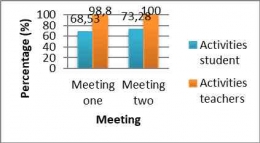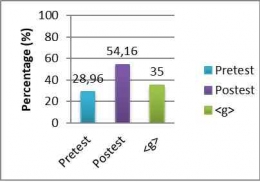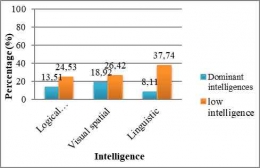ABSTRACT
The study was conducted to determine the increase of concept mastery, students' intelligence profiles and students' activity profiles through the application of multiple intelligences based learning in class VIII on subject material of IPBA in one of junior high school in Bandung. Pre-experimental design used was a one group pretest-posttest. While data collection tool used in the study were twenty five muliple choice questions, observation sheet of the accomplished learning and student activity sheets. The data proceeded in the cognitive learning area used normalized gain of the pretest and posttest score. The results showed a normalized gain of 0.35 in moderate category. The percentage of the average student intelligence for dominant intelligences naturalist with 55.26% and low in linguistic intelligence with 34.55%. The percentage of the average student activities for each meeting was 68.53% and 73.28% with the high category. Therefore, it can be concluded that the multiple intelligence based learning can increase of concept mastery.
Keywords: Multiple intelligences based learning, student intelligence profiles, student activities, and mastery of concepts.
1. Introduction
Indonesia has a unique geographical position so that the people of Indonesia were very necessary to understand the Earth and Space Sciences (IPBA) well in order to be able to explore and exploit the potential of natural resources that were available with their own efforts wisely. process learning IPBA according to junior high science curriculum should be more emphasis on students' understanding of various natural phenomena, concepts, and principles of science so that students can apply them in everyday life, and make them aware to appreciate nature as well as maintain and preserve it.
However, when given multiple choice questions on the topic of the solar system average student who answered correctly 8.75 to score a maximum of 20. This suggests that students' mastery of concepts IPBA class is still low. This was presumably related to the learning process that occurs that teachers only focus on linguistic intelligence and logic alone.
Intelligence not only includes two parameters, but also to be seen from the aspect of kinesthetic, musical, visual-spatial, interpersonal, intrapersonal, and naturalist (Kuadrat et al., 2010: 11). The types of intelligence are known as multiple intelligences (multiple intelligence) that was introduced by Howard Gardner in 1983.
One that facilitates the learning of all children's intelligence is a multiple intelligences based learning which was the learning that takes into account individual intelligence of each student. Please note every child has the intelligence and abilities in understanding a subject. An educator should not be forcing students to understand each material with the same understanding and perfect with a single dose of intelligence, because the situation of children in a different class.
Based on this research was then conducted with the aim to obtain information about the increase in students' mastery of concepts IPBA after multiple intelligences based learning applied.
2. Methods
The research methods used were experimental studies with a one group pretest-posttest design with the treatment of learning as much as two times.
Table 3.1 One Group Pretest-Posttest Design
- Pretest
- Treatment
- Posttest
- O1
- X
- O2
Sugiyono (2006:110)
Description:
O1 = Pretest carried out before treatment is given
X= Treatment
O2 = Posttest carried after being given treatment
Research samples are students of class VIII-C in one of the Junior High School in Bandung. Data is collected using the instrument in the form of multiple choice tests as many as 25 items that test mastery of the concept of IPBA, the profile of each student's intellect, observation sheet to know implemented learning and student activities. Increasing students' mastery of concepts is only restricted to the domain of cognitive C1 (knowledge), C2 (understanding) and C3 (the application). Increasing students' mastery of concepts can be seen from the normalized gain of the average pretest-posttest scores based on criteria Hake.
3. Research Results and Discussion
The results of observations of student activity can be seen in figure 4.1 below:
While the overall percentage of students' activity-based learning and multiple intelligences the involvement can be seen in Figure 4.2. Below:
 Figure 4.2 Diagram of Average Percentage of Student Activity-based learning and the involvement multiple intelligences/Dokpri
Figure 4.2 Diagram of Average Percentage of Student Activity-based learning and the involvement multiple intelligences/Dokpri
Based on figure 4.1 some students lower on naturalist intelligence and linguistics, so if the teacher emphasizes the logic and language skills course so if the teacher emphasizes the logic and language abilities alone then students would be difficult to accept the material presented by the teacher. Traditional patterns of thought that emphasizes the logic and language skills were already firmly entrenched on every teacher in the running process of learning. Intelligence not only includes two parameters, but also to be seen from the aspect of kinetic, musical, visual-spatial, interpersonal, intrapersonal, and naturalist (Kuadrat et al., 2010: 11). The types of intelligence were known as multiple intelligences that were introduced by Howard Gardner in 1983. Gardner also said that we tend to only appreciate the people who are experts in the ability of logic (mathematics) and language. We have to give balanced attention to people who have talent in other intelligences such as artists, architects, musicians, designers, dancers, therapists, and others.
The following were the results of the analysis of Concept Mastery IPBA Students who have already implemented that can be seen in Figure 4.3. Below:
 Figure 4.3 Diagram Score Pretest and posttest Mastery of Concepts/Dokpri
Figure 4.3 Diagram Score Pretest and posttest Mastery of Concepts/Dokpri
Based on figure 4.3 is known that the average score obtained by students prior to teaching a class experiment pretest was still low at 7.24, while after learning by using multiple intelligences learning based on average posttest score was increased to 13.54. Difference in mean value between pretest and posttest is indicated by the value of the gain that is equal to 6.30. When viewed from the gain normalized, then there was an increase in students' mastery of the concept of multiple intelligences after learning based categories are included with a value of 0.35 so it can be said that the mastery of the concept of IPBA student based learning applied to increase after multiple intelligences.
Here is a profile of intelligences in students who can be seen in Figure 4.4. Below:
 Figure 4.4 Diagram of the percentage of Intelligence in Students/dokpri
Figure 4.4 Diagram of the percentage of Intelligence in Students/dokpri
From the profile of intelligence on concept mastery test IPBA junior high school students who viewed only four intelligences that is logical mathematical, visual spatial, naturalist, and linguistics. It was found that students intelligence dominant naturalist with the percentage of 55.26% and the low linguistic intelligence with the percentage of 34.55%. Seen that students were used to link the learning materials with everyday life. This needs to be trained and socialized so that students know the benefits of science he had learned to everyday life that they experience. But either questionnaires or tests students' mastery of concepts intelligences low on linguistic, indeed it needs more effort to train students in classroom discussions and to familiarize students to participate in class discussions.
4. Conclusions
Based on the results of research and analysis of data obtained the conclusion is there was an increasing mastery of the concept of applied learning based IPBA after multiple intelligences seen from the normalized gain of 0.35 in moderate category. Intelligence profiles after multiple intelligences based learning applied to the average student is dominant intelligences Naturalists with a low percentage of 55.26% and linguistic intelligences with a percentage 34.55%. The percentage of the average profile of the student activity at the first meeting which is 68.53% while the average percentage of the activity profile of students at a second meeting is 73.28 which are both categorized properly.
5. References
- Depdiknas. (2006). Kurikulum Tingkat Satuan Pendidikan Sekolah Menengah Pertama. Jakarta: Depdiknas.
- Hake, R. R. (1998). Interactive Engagement Methods In Introductory Mechanics Courses. Departement of Physics, Indiana University, Bloomingtoon. [Online]. Tersedia: http://www.physics.indiana.edu/~sdi/IEM-2b.pdf. [7 Desember 2007]
- Kaya, O. (2008).How Is A Science Lesson Developed And Implemented Based On Multiple Inteligences Theory. [Online].Tersedia:http://www.eric.ed.gov/ERICWebPortal/search/detailmini.jsp?_nfpb=true&_&ERICExtSearch_SearchValue_0=EJ802521&ERICExtSearch_SearchType_0=no&accno=EJ802521.
- Sugiyono. (2006). Metode Penelitian Pendidikan (Pendekatan Kuantitatif, Kualitatif dan R&D). Bandung: Alfabeta
Follow Instagram @kompasianacom juga Tiktok @kompasiana biar nggak ketinggalan event seru komunitas dan tips dapat cuan dari Kompasiana. Baca juga cerita inspiratif langsung dari smartphone kamu dengan bergabung di WhatsApp Channel Kompasiana di SINI










